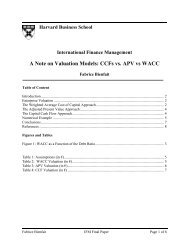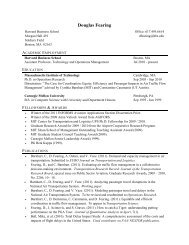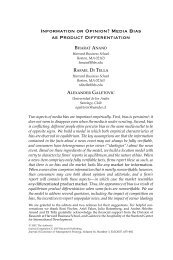Social Dimensions of Entrepreneurship. - People. hbs .edu ...
Social Dimensions of Entrepreneurship. - People. hbs .edu ...
Social Dimensions of Entrepreneurship. - People. hbs .edu ...
You also want an ePaper? Increase the reach of your titles
YUMPU automatically turns print PDFs into web optimized ePapers that Google loves.
We adopt an institutional economics approach as the basic analytical<br />
framework for this chapter. <strong>Social</strong> institutions are thus defined as the written and<br />
unwritten ‘rules <strong>of</strong> the game’: laws, norms, beliefs, etc. (North 1990). This<br />
framework is enriched primarily with insights from cross-cultural psychology, the<br />
discipline that specializes in cross-national comparisons <strong>of</strong> culture. Where possible,<br />
we draw connections to other disciplines, although we are influenced by both<br />
expertise limitations and a space constraint to focus on the teachings <strong>of</strong> economics<br />
and social psychology. The reader is referred to other chapters in this volume that<br />
focus in great depth on these other perspectives.<br />
Although this chapter is dedicated to social dimensions <strong>of</strong> entrepreneurship,<br />
we begin with a discussion <strong>of</strong> entrepreneurial motivations conducted at the individual<br />
level <strong>of</strong> analysis. <strong>Social</strong> institutions (especially culture and norms) affect the way<br />
individuals perceive the social role <strong>of</strong> the entrepreneur and how much individuals<br />
desire to become one. The documented richness <strong>of</strong> entrepreneurial motivations<br />
suggests that entrepreneurial behavior responds to a rich set <strong>of</strong> cues from the social<br />
environment.<br />
To organize the discussion <strong>of</strong> social institutions we draw on Williamson’s<br />
(2000) framework for institutional analysis. This model distinguishes four levels <strong>of</strong><br />
analysis. ‘Level 1’ consists <strong>of</strong> informal institutions. This is where norms, customs,<br />
mores, and traditions are located and where religion plays a role. More generally, this is<br />
the level <strong>of</strong> culture. Level 2 consists <strong>of</strong> formal legal rules and regulations, comprising<br />
constitutions, law, property rights, etc. Informal institutions exist in the shared<br />
subjective knowledge <strong>of</strong> societal members. Formal institutions are relatively more<br />
objectively verifiable through formal documents. Institutions at both Levels 1 and 2<br />
usually apply generally to all societal members. Minority sub-groups may develop<br />
3
















